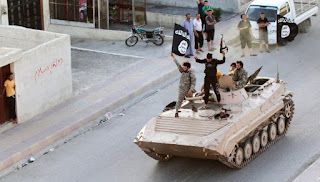Some ISIS Running Away to Libya
Eyes, guns and missiles are aimed at Iraq and Syria, with allied and Russian airstrikes mounting pressure against Islamic State’s so-called caliphate. But as the West doubles down and the militants’ territorial losses rack up, the jihadists may simply be moving on to Plan B. When the going gets tough — for the tough guys themselves — will they head for the hills or simply move the fight … to Libya?
For many, the going got tough in Syria and Iraq, and they got going. Millions have escaped and continue to flee, braving treacherous maritime crossings — often dying — and months in freezing European camps in the hope of carving out a better life. But now the militants are also feeling the heat, and possibly taking more advantage of Libya’s instability. Already, experts say, they’ve lost up to 25 percent of their territory in Iraq, along with some key oil refineries, and pressure’s mounting, thanks to allied and Russian airstrikes. Combined, it’s getting harder for ISIS to protect the areas they “govern” and keep their machine running by collecting taxes without expanding into other areas. Meanwhile, says Joshua Meservey, the Heritage Foundation’s policy analyst for Africa and the Middle East, Libya has become a “backup plan” or “haven” for if and when things turn sour in Iraq and Syria.
Of course, ISIS isn’t on its back heels. The caliphate model of gaining territory and taxing local populations is still going strong, and the militants are putting more resources into the Maghreb. And while the group has had a presence in Libya since 2014, it’s increasingly shifting eggs from one basket — Syria and Iraq — to the late Moammar Gadhafi’s homeland, where two governments are now vying ineffectively for control. That leaves loads of groups duking it out in a vacuum that ISIS has proven all too effective at monopolizing before, especially in Syria.
It’s going to become increasingly important to focus on Libya.
Right now, ISIS has anywhere from 2,000 to 10,000 fighters in Libya, experts estimate. That’s a relatively small number when looking at the country as a whole, though it’s significant if ISIS members are concentrated in a town or specific area because “they can run little areas,” says Professor Daniel Byman of Georgetown University’s Security Studies Program. And this piecemeal grabbing of land, and then exploiting resources and local bank accounts, is exactly how the militants roll.
Indeed, the militants have carved out a beachhead in the coastal city of Sirte and are upping attacks against oil fields in a bid to secure lucrative resources in the north. So far these efforts have been fairly amateur, says Madeleine Moreau, a strategic media analyst for Global Risk Insights based in Beirut. But she notes that high-level ISIS leaders are leaving Syria and going to Libya to take advantage of the chaos, especially in the north, fueling fears that over the next six months, “it’s going to become increasingly important to focus on Libya.”


Comments